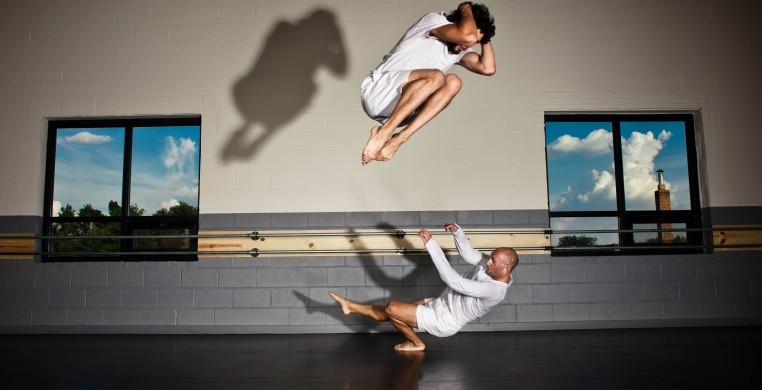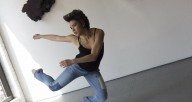Hovering over, lying underneath and interwoven into the whole idea behind Moving Canvas is an age-old, multi-faceted term crucial to the arts: collaboration.
Where would Gilbert be without Sullivan? But it's not always so clear-cut: Where would Shakespeare, for that matter, be without all the source materials that provide the bulk of his plots? Filmmaker Ingmar Bergman once plaintively saluted the countless, anonymous medieval craftsmen who built the great cathedrals as among the most noteworthy of Western artists.
The Moving Canvas series explores another aspect of collaboration, the interdisciplinary meeting of two art forms, their artists and their audiences, who collaborate right along with the rest. In the third installment scheduled Wednesday, April 16, dancers with the Nexus Project will perform amidst an exhibit at the Chicago Artists Coalition at 217 N. Carpenter St. serendipitously titled "Quasi-Choreography" and curated by Alexandria Eregbu.
This time the meeting point is uncannily fortuitous. In one of the most fascinating coincidences in the series so far, curator Eregbu and the artists involved in Nexus independently, long before the scheduling of the Moving Canvas event, envisioned their separate projects as means to unearth subtly layered aspects of collaboration involved in the artistic enterprise.
In the exhibit with works by three artists at CAC, Eregbu sought to explore the complex interplay of works and ideas involved when visual artists are brought together. On Friday, April 11, Eregbu will nudge this concept into motion by having the three artists provide each other with instructions that will then be enacted and/or dealt with by the artists. The artists will give orders to each other.
Meanwhile, Benjamin Holliday Wardell and Michel Rodriguez Cintra will perform Nexus duets Wednesday that include snatched snippets drawn and remixed from 12 discreet duets created earlier and separately by a dozen Chicago choreographers--collaboration, as it were, crafted onto the work after the fact.
"We agreed with the choreographers from the very beginning that they would hold the rights to their original duets, but that we would be able to remix, blow apart and re-textualize the work in any way we wanted, a mishmash of all these different styles," explained Wardell, a sharp, keen dancer in his stretch as a Hubbard Street Dance Chicagoan from 2007 to 2011.
Why?
"It's a desire to try a different way of making a work of dance," Wardell said. "All my career I'd only worked in the creation of dances in one way, in which the choreographer is a kind of god in the room."
Wardell believes that there's a communal, interdisciplinary wave in all the arts right now, and Nexus is a way to explore that phenomenon in dance. His vision is rich and complicated, nothing less than exploding what he sees as the classic hierarchy of dance and all artistry and inverting key underlying structures in choreographic creation. "When you're thrust into a room with someone else from another discipline who's also used to being the god in the room, how do you work with them?"
Three other factors influence Wardell's motivation. He sees himself as more of a facilitator and producer than originator of original movement, so the set-up of Nexus allows him to play this buzzing-bee-like role, moving from choreographer to another as advisor/producer. He also believes the male duet is under-explored in the art. By offering 12 choreographers the chance to create work they know will be incorporated along side that of others, they may well be challenged competitively to aspire to their best. "Most performances feature a lot of dancers and a single choreographer," he added. "This flips that around, a performance with many more choreographers than dancers."
And he sees the project as a different arts-business paradigm from the rushed and intimidating world of repertory dance companies. "How do you provide choreographers with a safe environment in the arts, with the luxury to experiment and fail?" he asked. "Dance is extremely under funded, and if a piece isn't judged a great success, the costs to the artist can be tremendous." With Nexus, instead, the choreographer is in some ways as anonymous as a cathedral craftsman.
Meanwhile, the exhibit Quasi-Choreography features work by Delaney DeMott, Hope Esser and Megan Stroech.
"I come into the art world as a performance artist, so I'm very consciously aware of the body, even when I'm not intentionally trying to think about it," Eregbu said of the exhibit's title. "I was thinking of the exchange, of the conversation that happens among artists and their work. I think there's a poetry in the sense of the formal relationships in the space, and there are several ways a viewer can go into an exhibit and see different conversations going on."
On Friday, that conversation will travel to another plane. "The artists wrote what I call scores for each other, sets of directions that require response," Eregbu explained. "Delaney, for instance, takes titles from her previous works and asks Hope to respond."
Eregbu calls these interactions "interventions," a slyly combative term that suggests the provocative depth involved in collaboration, by no means a universally easy process. "One of my missions is to open up exhibitions for programming, and collaboration is very important in that," Eregbu said. "So I was excited when I heard about [Moving Canvas] project, because it so perfectly fit the exhibition."
Eregbu's intervention concept will be played out in a different way, with dancers and dance artists tossed into the mix, at Wednesday's event.
Eregbu's intervention concept will be played out in a different way, with dancers and dance artists tossed into the mix, at Wednesday's event.
Wardell sees collaboration as a deep foundation to artistic achievement.
"As an individual, I'm less interested in the piece of art I'm making than in the relationships with other artists that come about from making art," Wardell said. "I love creating processes that lead to intricate and elaborate relationships between artists, and having those relationships put on display. Good artistic relationships lead to good artistic productions."


